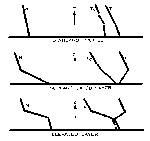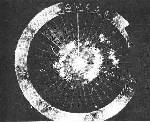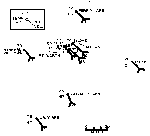
Figure 1: 2:00 AM Weather Data
Click on Thumbnail to see Full-size image.
Of special importance in this investigation was some research work
done at Texas A & M using their 3.2-Cm. AN/CPS-9 weather radar. The
report, prepared by L. B. Cobb and V. E. Moyer, covers research
carried out in 1962 and 1963, supported by National Science
Foundation Grant NSF G-13834. This study was particularly interested
in abnormal PPI presentations of radar echoes that occurred during
clear weather.
The effect of atmospheric refraction on microwave propagation in the
lower troposphere is a problem with which radio engineers and radio
meteorologists have been vitally concerned since World War II.
Prior to that time, the speed of propagation of electromagnetic energy
had been considered to be a constant, that of the speed of light in
a vacuum. As radar, missiles, and other radio-controlled equipment
were developed and became more complex, evidence of small changes in
the speed of propagation due to atmospheric conditions began to
mount. These small changes in speed are very important as they cause
refraction, or a change in the direction of propagation, of the
electromagnetic energy. Radar trapping, errors in the positioning of
targets, the radio hole, fading of radio signals, and "anomalous"
echoes on weather radar scopes are some of the problems encountered.
Any observer who makes critical deductions based on radar
observations may be tricked into bad decisions unless he is familiar
with the limitations of the equipment under nonstandard atmospheric
conditions. Radar echoes of unknown origin near a vertical beam above
the earth's surface are commonly called "angels". Unusual echoes from
the surface are generally referred to as "anomalous propagation" or
"AP". Both of these phenomena have been ascribed to abnormal
refraction of the radio ray,
A study of abnormal radar echoes made at Texas A & M dealt primarily
with anomalous propagation brought about by ducting or bending of
radar beams due to inversions near the surface, They studied the
expansion of ground clutter echoes due to increased gradient of
refractive index near the surface. They examined large areas of
anomalous echoes separated from the normal ground clutter pattern
brought about by both strong surface inversions and strong upper
level inversions.
The index of refraction, n, of electromagnetic energy in a non-dispersive
medium such as the troposphere is defined as the ratio of the speed of
propagation in a vacuum to the speed of propagation in the medium:
The index of refraction is a function of temperature, pressure, and
humidity, their relationship being given by the equation
Standard propagation occurs when the atmosphere is stratified
vertically in such a way that a lapse of 12 N-units occurs in each
1000 ft. Under these conditions, a horizontal radar ray will be bent
downward slightly due to increasing velocity aloft. This increase in
velocity is very small; e.g., in the time it takes the horizontal ray
to travel 1 mi at the surface, it will travel 1 mi. plus 3/4 in. at a
height 1000 ft above the surface. This has the effect of extending
the radar horizon about 15 per cent beyond the geometric horizon,
Nonstandard propagation will result when the temperature or water
content of the atmosphere vary significantly from so-called
"standard" values. Substandard refraction, i.e., less downward
bending or possible actual upward bending of the radar ray, will
occur if the refractivity is constant or increases with height. The
propagation is superstandard if the refractivity decreases with
height at a rate exceeding the standard rate. This causes an
increased downward bending of the ray. If the velocity difference
between the surface and 1000 ft achieves 3 in./mi of horizontal
travel, as occurs with a refractivity of -48N/1000 ft., a ray
will have the same curvature as the earth with resultant greatly
extended horizons, a condition referred to as "ducting."
Super refraction normally results from a combination of increasing
temperatures and decreasing humidities with height. Nocturnal
radiational cooling at the surface and normal lack of nighttime
convection will cause a temperature inversion, if other physical
parameters are favorable, These
Elevated super-refractive layers also occur with temperature
inversions or in stable layers in which there is a decrease in
moisture with height. Subsidence inversions are the most common cause
of this situation.
When the beam of a radar unit is used to cover a large horizontal
area - from 200 to 300 miles - the elevation angle of the beam must
be at or near zero. Near the radar site, even when the antenna is
several feet above the around, part of the energy is "echoed" back
from nearby objects and/or the ground itself. As the energy goes
farther and farther from the radar site the curvature of the earth
permits the beam to extend into the air mass higher and higher above
the earth's surface. The local terrain surrounding any particular
radar location helps define the topical ground pattern. Figure 5
shows the topographic map of area within 150 miles of College
Station, Texas.
A standard pattern must be determined if one wishes to ascertain the
degree of abnormality of nonstandard patterns. Figure 6 presents the
PPI (Plan Position Indicator) pattern for College Station with the
elevation angle set at 00 and a full gain setting of the receiver. It
is the ground return pattern associated with standard refraction in
the atmosphere. The black circle shown in Figure 6 encloses an area
inside 25 miles from the radar site at College Station (CCL). The
terrain features in Figure 5 are reflected in this normal ground
pattern. For example, the line of echoes oriented southwest -
northeast (approximately 25 miles south of OLL) represents the ridge
which rises south of Yegua Creek west of Navasota. The low ground
along the three streams - Brazos River, Yegua Creek, Navasota River -
is indicated by the converging blue lines which join to form the
expanded Brazos River near Navasota before it heads southeastward to
empty into the Gulf at Freeport.
Figure 6 can be reproduced with a 00 beam angle and a near standard
atmosphere day after day at College Station, Texas, and can be
considered the normal ground pattern. A standard pattern must be
determined if one wishes to ascertain the degree of abnormality of
nonstandard patterns.
Eleven cases were studied in which anomalous propagation caused an
expansion of the normal ground pattern. The amount of additional echo
observed varies from scattered, small additions to large areas of
anomalous echoes which extend beyond the 50 mi range. The eleven
cases were divided roughly according to whether they had small or
large amounts of AP. Examples from each division are shown in Figures
7 and 8. The black circles enclose the same 25 mile radius area in
these figures as in Figure 6.
The difference in amount of anomalous echoes appear to depend upon
the gradient and thickness of the surface refracting layer. All of
the smaller amounts occurred with gradients between 18N/1000ft and
30N/1000 ft; the larger amounts occurred with gradients between
26N/1000 ft and 40N/1000 ft. In general, the refracting layer was
thicker when the larger amounts of anomalous echoes were observed.
However, the thickness of the surface refracting layer was less than
1600 ft in all cases.
The anomalous echoes are related to the topographic features.
Comparison of Figure 7 with a map of the terrain shows that the
excess echoes (indicated by white arrows) are reflections from hills
at those locations. These hills are not detected under standard
refractive conditions, but are detected when the radar ray is bent
one and one-half to two times the standard rate of bending. Greater
bending of the ray will cause additional topographic features to be
presented on the PPI (Figure 8).
The examples that are included in this group are those which have
anomalous echoes at a considerable distance from the normal ground
pattern. In some cases, these echoes encircle the local area; in
others, they are confined to one or two quadrants. In most cases,
they appear to be caused by an elevated ducting layer.
Two examples of anomalous echoes which encircle the local area are
considered first. Figures 9 and 10 are examples of "radial
patterns" which occurred on 7 May 1962 and 12 February 1962. The
black circles again chow an area of 25 miles radius nearest OLL. A
polaroid photograph is presented for 7 May because the regular
photographs were not useable. In the case of 12 February, there had
been a complete ring of echoes earlier, but those in the eastern
quadrants had begun to disappear by 0820CST, when the photograph was
taken. The refractivity profiles for both dates were very similar.
A large anticyclone was located over the Gulf of Mexico at the
surface, with a smaller high-pressure area aloft centered over Texas,
on both 7 May 1962 and 12 February 1962. Thus, there was a layer of
moist Gulf air near the surface, overlain by a very dry layer caused
by subsidence. Nocturnal radiational cooling at the surface, together
with the subsidence warming aloft, created a very sharp inversion.
These are the ideal conditions for the formation of an elevated
super refractive layer, with
There are several characteristics which distinguish these echoes from those
discussed previously. First, a radial pattern is caused by total or
near-total refraction from an elevated layer, so that its location is
dependent on the vertical distance between the radar and the layer, as well
as on the antenna elevation angle. Terrain features are of secondary
importance in giving the pattern its shape and location. Second, these
echoes usually persist longer because it takes much more convective mixing
to destroy an elevated layer than is needed to destroy a layer next to the
surface. Third, elements of a second ring of echoes are often observed;
they probably result from a second "bounce" of the ray between the surface
and the refracting layer.
A good example of anomalous echoes associated with the formation of
an elevated refracting layer occurred during the night of 27 April
1962. An elongated low-pressure trough aloft, extending from Illinois
to central Texas, triggered severe thunderstorms as it moved eastward
during the day. Clearing occurred over the southern half of the state
during the afternoon, but thunderstorms continued in the
Dallas-Shreveport area. Moist Gulf air was flowing northward aloft,
ahead of the trough, at the time of the 0000 UT radiosonde soundings;
it was replaced by very dry air from the west after passage of the
trough. Figure 11 shows the refractivity profiles for San Antonio
(SAT) and Lake Charles (LCH) at 0000 Universal Time (UT) and 1200UT,
28 April (1800 CST, 27 April and O600 CST; 28 April); the profile for
Ft. Worth (ACF) is not shown as it did not change appreciably from
one sounding to the next. The formation of an elevated
superrefractive layer is clearly indicated at both stations between
the times of the two soundings. Figure 12 shows the AP echoes which
had formed in the southern quadrants by 2250CST (skies were then
clear); the echoes to the north were caused by thunderstorms.
The last example to be considered in this group occurred on 9
February 1962 (Figure l3a-e). Skies were generally clear over the
state, except for some early morning fog along the coast and low
stratus clouds which dissipated as the temperature increased. A large
high-pressure area was situated over the southeastern United States,
so that warm, moist air was flowing northward from the Gulf at the
lower levels. Cold, dry air aloft had entered Texas from the
northwest; the 1200UT refractivity profiles (Figure 14) indicate that
this air had not reached LCH. Very strong super refractive layers
existed at ACF and SAT; it appears to be a reasonable assumption that
such a layer existed at CLL also, if one considers the amount of
anomalous echoes that were occurring (Figure 13a-e). Both the
profiles and the photographs demonstrate that the pattern was not a
true radial pattern at 0850CST, although echoes occurred in all
directions. During the next 15 min, heating and convective mixing
began to destroy
In Chapter 13 of the Handbook of Geophysics for Air Force Designers,
published by the U. S. Air Force in 1957, various equations, tables, and
nomograms are presented covering electromagnetic wave propagation in the
lower atmosphere. Figures 15 and 16, as copied from that book, show how
refractive modulus values vary with altitude for both optical and radio
wavelengths. As shown in Figure 16 the two curves for optical and radio
wavelengths converge at altitudes greater than 20,000 feet. This would
indicate that any abnormal ducting of optical and/or radar type images
might be similarly distorted to observers in aircraft flying above 20,000
feet when atmospheric abnormalities are uniquely favorable for anomalous
propagation.
At the Ninth Weather Radar Conference in Kansas City in 1961, R. Q.
Tillman, R. E. Ruskin, and M. N. Robinson of the U. S. Naval Research
Laboratory, reported on the tracking of approximately 500 clear air
"angel" echoes. Most of the "angels plotted had radar cross sections
between approximately 0.2 and 3 cm 2
The maximum detectable range usually fell between 2,000 and 4,000
yards. On occasion, distinct angels with the appearance and
characteristics of large airplanes or vessels were tracked,
presenting targets roughly 100 times the minimum detectable target at
that range. The physical extent of most of the angels, as deduced
from manually varying the range setting across the target, was
approximately 35 yards.
A series of attempts was made to vector an instrumented WV-2
SuperConstellation aircraft through. the apparent location of the
angel echoes. Of 28 attempts, 4 were successful. The plane was
directed by radio by the radar operators, using the altitude and
beading information from the plotting boards. On the four successful
runs the plane passed directly through the telescope cross hairs, and
its radar return was visible in the range notch of the A-scopes. In
each case the radar shifted to this stronger target. However, in one
run it was possible to unlock momentarily from the plane and to pick
up the angel again. On another occasion, the angel echo disappeared
when the aircraft passed through. The aircraft instrumentation
included: a rapid-response refractometer, a vortex thermometer,
electric field and conductivity instruments, and space charge
detector. In none of the four instances was there any correlation
between
Cloudless skies and good visibility prevailed at the time of the UFO
sightings in an area from 50 miles east of Dallas to Mineral Wells,
Texas in the early morning hours of September 19, 1957. Therefore,
the UFO sightings were not related to cloudiness, lightning, or radar
echoes from shower activity near the flight path.
The vertical profile of the atmosphere as measured at Ft. Worth did
contain a sharp temperature inversion near the 6000 - 7000 foot level
(Figure 2). The temperature increased and moisture content decreased
rapidly with height in this layer. The change with height was great
enough to permit a corresponding gradient of refractive index near
the critical level which allows extensive anomalous propagation of
either optical or radar energy (see Figures 3 and 16). The aircraft
crew, although flying above the ducting layer, could have been
receiving echoes and/or images of objects or lights many miles from
the path of the aircraft. The ground operators of radar, located
below the ducting layer, probably were observing echoes which were
part of an anomalous propagation pattern transmitted to them due to
the elevated refracting layer.
The air mass itself would have been changing slowly with respect to
time during the night time hours. From a fixed position the ground
radar operators would have been able to detect anomalous propagation
near one particular position for fairly long periods. By contrast the
airborne equipment would have been constantly changing its position
relative to both the surrounding atmosphere and terrain. The probable
ducting of images from considerable distances through the layered
atmosphere would have tended to keep the images in the same general
direction from the aircraft and at some distance away from the
aircraft itself. This is in some ways similar to the observation of a
rainbow from a moving automobile.
It is worthy to note that a large fraction of the reports on detailed
research which have been used as references for the conclusions in
this study have publication dates after September 1957. Even in 1968
it is not likely that the results of such research are common
knowledge to a high fraction of aircraft crews who might on rare
occasions fly near a "ducting layer" which is invisible in a
cloudless atmosphere.
The detailed observations are being retained in my files. Should they
be of further use to you please let me know.
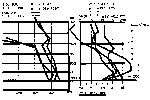
Figure 2: Temperature, etc. Profiles
Click on Thumbnail to see Full-size image.
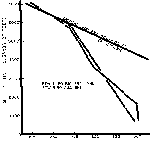
Figure 3: Refractivity Profiles
Click on Thumbnail to see Full-size image.
Figure 4: Refractivity Index Models
Click on Thumbnail to see Full-size image.
EXTRAORDINARY RADAR ECHOES
n
=
vair
(1)
N
=
(n - 1)106
(2)
N
=
(n - 1)106
=
T
+
T2
(3)
* slightly different than values presented by Bean and Dutton.
LOCAL TERRAIN SURROUNDING COLLEGE STATION, TEXAS
NORMAL GROUND PATTERN
EXPANSION OF NORMAL GROUND PATTERN
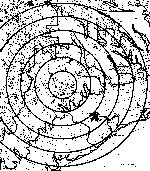
Figure 5: Topographic Map
(plus detailed sub-maps)
Click on Thumbnail to see Full-size image.
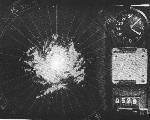
Figure 6: Normal Ground Pattern
Click on Thumbnail to see Full-size image.
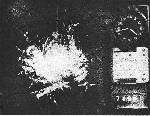
Figure 7: Expanded Ground Pattern
Click on Thumbnail to see Full-size image.
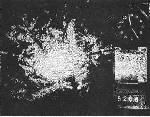
Figure 8: Expanded Ground Pattern
Click on Thumbnail to see Full-size image.
LARGE AREAS OF ECHO SEPARATED FROM THE NORMAL GROUND PATTERN
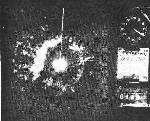
Figure 9: Radial Echo Pattern
Click on Thumbnail to see Full-size image.
Figure 10: Radial Echo Pattern
Click on Thumbnail to see Full-size image.
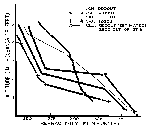
Figure 11: Refractivity Profile
Click on Thumbnail to see Full-size image.
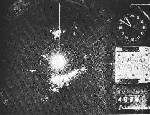
Figure 12: Elevated Refracting Layer
Click on Thumbnail to see Full-size image.
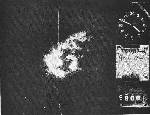
Figure 13a: Super-Refractive Layer
Click on Thumbnail to see Full-size image.
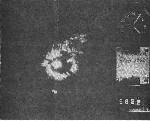
Figure 13b: Super-Refractive Layer
Click on Thumbnail to see Full-size image.
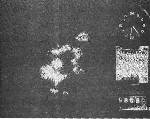
Figure 13c: Super-Refractive Layer
Click on Thumbnail to see Full-size image.

Figure 13d: Super-Refractive Layer
Click on Thumbnail to see Full-size image.
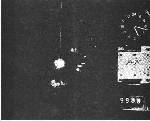
Figure 13e: Super-Refractive Layer
Click on Thumbnail to see full-size image.
OPTICAL AND RADIO PROPAGATION
AIRCRAFT PENETRATION OF CLEAR AIR "ANGELS"
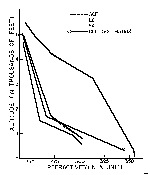
Figure 14: Refractivity Profiles
Click on Thumbnail to see Full-size image.
SUMMARY
LWC :dd
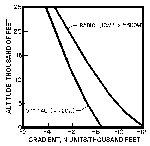
Figure 15: Refractivity Modulus Gradient
Click on Thumbnail to see Full-size image.
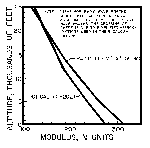
Figure 16: Refractivity Modulus Variation
Click on Thumbnail to see Full-size image.
